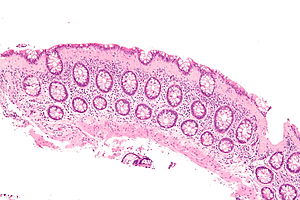Ischemic colitis
- Category: Gastroenterology
- Views: 46665

Ischemic colitis occurs when blood flow to part of the large intestine (colon) is reduced, usually due to narrowed or blocked blood vessels (arteries). The diminished blood flow doesn't provide enough oxygen for the cells in your digestive system.
Ischemic colitis can cause pain and may damage your colon. Any part of the colon can be affected, but ischemic colitis usually causes pain on the left side of the belly area (abdomen).
The condition can be misdiagnosed because it can easily be confused with other digestive problems. Ischemic colitis may heal on its own. But you may need medication to treat ischemic colitis or prevent infection, or you may need surgery if your colon has been damaged.
Microscopic colitis
- Category: Gastroenterology
- Views: 43794

Microscopic colitis is an inflammation of the large intestine (colon) that causes persistent watery diarrhea. The disorder gets its name from the fact that it's necessary to examine colon tissue under a microscope to identify it, since the tissue may appear normal with colonoscopy or flexible sigmoidoscopy.
The Gastritis
- Category: Gastroenterology
- Views: 82127

Gastritis describes a group of conditions with one thing in common: inflammation of the lining of the stomach. The inflammation of gastritis is most often the result of infection with the same bacterium that causes most stomach ulcers. Injury, regular use of certain pain relievers and drinking too much alcohol also can contribute to gastritis.
Gastritis may occur suddenly (acute gastritis), or it can occur slowly over time (chronic gastritis). In some cases, gastritis can lead to ulcers and an increased risk of stomach cancer. For most people, however, gastritis isn't serious and improves quickly with treatment.
The Angina
- Category: Diseases of the ear, nose and throat
- Views: 86171

Angina is a term used for chest pain caused by reduced blood flow to the heart muscle. Angina is a symptom of coronary artery disease. Angina is typically described as squeezing, pressure, heaviness, tightness or pain in your chest.
Angina, also called angina pectoris, can be a recurring problem or a sudden, acute health concern.
Angina is relatively common but can be hard to distinguish from other types of chest pain, such as the pain or discomfort of indigestion. If you have unexplained chest pain, seek medical attention right away.
The Adenoids
- Category: Diseases of the ear, nose and throat
- Views: 82140
Adenoids and tonsils are often talked about together. You can see your tonsils in the back of your throat, but where are your adenoids? For that matter, what are your adenoids? Let's find out.
The Vestibular Disorders
- Category: Diseases of the ear, nose and throat
- Views: 50508
The vestibular system includes the parts of the inner ear and brain that process the sensory information involved with controlling balance and eye movements. If disease or injury damages these processing areas, vestibular disorders can result. Vestibular disorders can also result from or be worsened by genetic or environmental conditions, or occur for unknown reasons.
The Sore Throat
- Category: Diseases of the ear, nose and throat
- Views: 51095
Why Is Your Throat Sore?
The average person swallows about 50 times per minute. How do you measure up? It’s okay if you have no idea, because most guys don’t gauge their gulps.
Unless you have a sore throat, that is. If so, you’re painfully aware of each and every time you need to push something down your thick, burning throat, even if it’s just something as simple as your own spit.
Throat symptoms are one of the most common reasons people go see their doctor, ranking above high blood pressure, back problems, and rashes, according to the National Ambulatory Medical Care Survey.
The sinusitis
- Category: Diseases of the ear, nose and throat
- Views: 52007
Sinusitis is an inflammation, or swelling, of the tissue lining the sinuses. Normally, sinuses are filled with air. But when they become blocked and filled with fluid, germs (bacteria, viruses, and fungi) can grow and cause an infection.
Conditions that can cause sinus blockage include the common cold, allergic rhinitis (swelling of the lining of the nose), nasal polyps (small growths in that lining), or a deviated septum (a shift in the nasal cavity).
The otitis
- Category: Diseases of the ear, nose and throat
- Views: 51089
Otitis media (OM) is any inflammation of the middle ear (see the images below), without reference to etiology or pathogenesis. It is very common in children.
The head cold
- Category: Diseases of the ear, nose and throat
- Views: 50992

A head cold is basically the common cold. It gets its name because the symptoms tend to be centred around the head and facial region more than a usual cold would. Head colds generally last between a week and ten days, and often the symptoms are manageable without medical attention.




